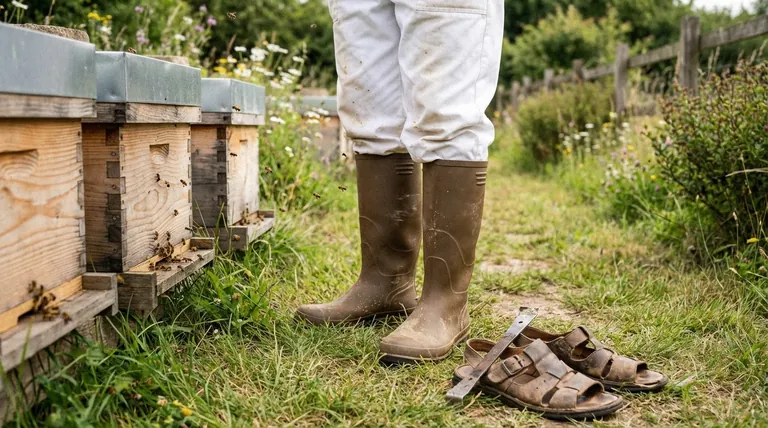Above all, avoid any footwear that leaves your skin exposed. The most common mistake is wearing sandals, flip-flops, or any open-toed shoe. This is because your feet and ankles are a primary target for guard bees, and any gap in your protective gear is an open invitation for them to enter your suit.
Your footwear is not just a covering for your feet; it is a critical component of a completely sealed system. The primary goal is to choose a boot that eliminates any potential entry point for a bee between your foot and your pant leg.

The Core Principles of Protective Footwear
Choosing the right footwear goes beyond simply avoiding sandals. It's about understanding what makes a shoe effective at preventing stings and providing stability in the apiary.
Prioritizing Complete Coverage
The most fundamental rule is to leave no skin exposed. Bees are naturally drawn to investigate dark, covered spaces, and the gap between a shoe and a pant leg is an easy target.
Footwear like sandals, clogs, Crocs, or low-cut sneakers are entirely unsuitable. They fail to protect the vulnerable ankle area and provide numerous entry points for determined bees.
Eliminating Bee Entry Points
A successful bee sting to the foot or ankle often happens not through the material, but because a bee crawled inside your clothing. Your boot choice is central to preventing this.
The ideal footwear is a tall boot that allows you to securely tuck your bee suit or pants inside. Alternatively, you can pull your pant legs down over the boots and secure them with straps or the suit's built-in elastic. The goal is to create an impassable, overlapping seal.
Ensuring Material is Sting-Resistant
While bees are less likely to sting through thick material on your feet, it's still a consideration. A bee's stinger can potentially penetrate thin canvas or stretched fabric.
Boots made of rubber, leather, or thick non-porous synthetic materials are superior to cloth or mesh sneakers. They provide a smooth, impenetrable surface that a stinger cannot grip or pierce.
Understanding the Trade-offs
The perfect beekeeping boot is a balance of protection, comfort, and practicality. What works for a quick hive check may not be suitable for a long day of honey harvesting.
Protection vs. Comfort
Seamless rubber boots (Wellingtons) offer the highest level of protection. They are completely waterproof, sting-proof, and have no laces or seams for bees to get caught in. However, they can be hot, sweaty, and less comfortable for long periods.
Leather work boots or hiking boots offer a good compromise. They provide excellent ankle support and are more breathable, but you must ensure they have no mesh panels and that the laces are pulled tight to minimize gaps.
The Hidden Danger of Laces
Standard boot laces can present a minor but annoying hazard. A bee can become trapped in the eyelets or tangled in the laces, which can provoke it and its nearby sisters to sting.
While not a primary concern, beekeepers who want to minimize all risks may prefer pull-on boots (like Blundstones or Wellingtons) or boots with a zipper covered by a flap.
Making the Right Choice for Your Goal
Select your footwear based on your specific needs for protection, comfort, and the type of work you'll be doing in the apiary.
- If your primary focus is maximum, fail-safe protection: Choose tall, seamless rubber boots that you can tuck your pants into.
- If your primary focus is all-day comfort and mobility: Select a sturdy, all-leather hiking or work boot that fully covers the ankle, and ensure your pant leg is secured over it.
- If your primary focus is working on a budget: Use any fully enclosed boot that covers the ankle, and pay extra attention to securely sealing the junction with your pant leg using straps or duct tape.
Ultimately, the best footwear is the one that allows you to work confidently and safely, knowing you are completely sealed from the ground up.
Summary Table:
| Aspect to Consider | What to AVOID | What to CHOOSE |
|---|---|---|
| Coverage | Sandals, flip-flops, low-cut sneakers | Tall boots that cover the ankle |
| Seal/Entry Points | Shoes with gaps between pant leg and boot | Boots that allow pants to be tucked in or pulled over |
| Material | Thin canvas, mesh, or porous fabrics | Rubber, leather, or thick non-porous synthetics |
| Comfort vs. Protection | Prioritizing comfort over a complete seal | Choosing based on task: rubber for max protection, leather for mobility |
Work with Confidence and Total Protection
Equip yourself and your operation with the right gear from the ground up. HONESTBEE supplies durable, sting-resistant beekeeping footwear and full protective equipment designed for the demands of commercial apiaries and distributors.
We understand that your safety and efficiency are paramount. Our wholesale-focused operations ensure you get the reliable, high-quality equipment you need.
Contact HONESTBEE today to discuss your beekeeping supply needs and secure your apiary's first line of defense.
Visual Guide

Related Products
- Wholesales Dadant Size Wooden Bee Hives for Beekeeping
- Yellow Plastic Bucket Pail Perch for Beekeeping
- Long Langstroth Style Horizontal Top Bar Hive for Wholesale
- Automatic Honey Flow Beehive 4 Frame Mini Hive for Beekeeping
- Heavy Duty Cowboy Beekeeper Hat with Visibility Veil Outdoor Professional Beekeeping Protective Gear
People Also Ask
- What is beekeeping equipment? Essential Tools for Commercial Apiaries & Distributors
- What are the essential pieces of equipment for most beekeepers? Get Started with the Right Gear
- What are the characteristics of oil-based paint for beehives? Durability vs. Modern Practicality
- How often should the area under beehives be inspected and cleaned during the warm season? A Proactive Maintenance Guide
- Why were wooden hives traditionally preferred? For Natural Beekeeping Aligned with Bee Biology



















